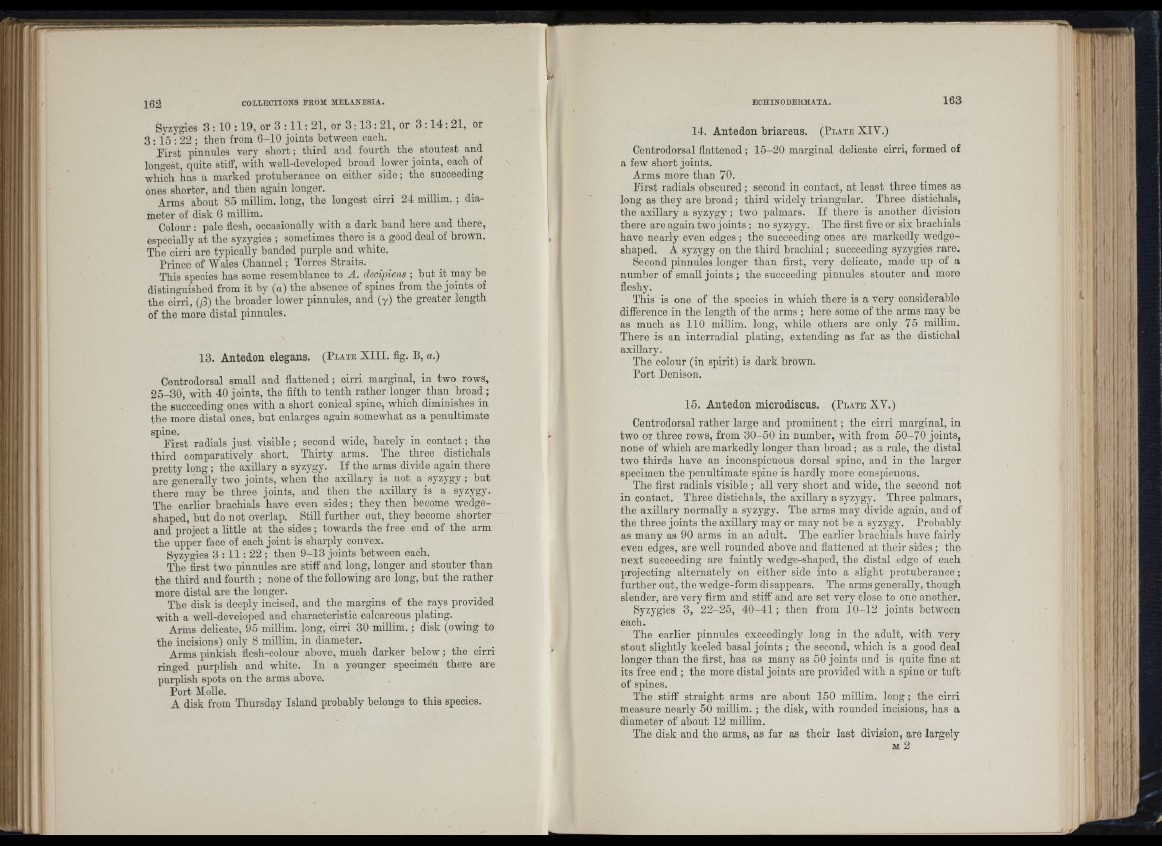
I
fin
11:
i
I r
I
162 COLLECTIONS FROM MELANESIA.
Syzygies 3 : 10 : 19, or 3 : 1 1 : 21, or 3 :13 : 21, or 3 :1 4 : 21, or
3 :1 5 ; 22 ; then from 6-10 joints between each.
First pinnules very short; third and fourth the stoutest and
longest, quite stiff, with well-developed broad lower joints, each of
which has a marked protuberance on either side; the succeeding
ones shorter, and then again longer.
Arms about 85 millim. long, the longest cirri 24 millim. ; diameter
of disk 6 millim.
Colour : pale flesh, occasionally with a dark band here and there,
especially at the syzygies ; sometimes there is a good deal of brown.
The cirri are typically banded purple and white.
Prince of Wales Channel; Torres Straits.
This species has some resemblance to A. decipiens ; hut it may be
distinguished from it by (a) the absence of spines from the joints of
the cirri, (/3) the broader lower pinnules, and (y) the greater length
of the more distal pinnules.
13. Antedon elegans. (P late X l l l . fig. B, a.)
Centrodorsal small and flattened; cirri marginal, in two rows,
25-30, with 40 joints, the fifth to tenth rather longer than b ro ad ;
the succeeding ones with a short conical spine, which diminishes in
the more distal ones, but enlarges again somewhat as a penultimate
spine.
First radials ju st visible ; second wide, barely in contact; the
third comparatively short. Thirty arms. The three distichals
pretty long ; the axiUary a syzygy. I f the arms divide again there
are generally two joints, when the axillary is not a syzygy; but
there may be three joints, and then the axillary is a syzygy.
The earlier brachials have even sides; they then become wedge-
shaped, but do not overlap. StiU further out, they become shorter
and project a little at the sides; towards the free end of the arm
the upper face of each joint is sharply convex.
Syzygies 3 : 1 1 : 22 ; then 9-13 joints between each.
The first two pinnules are stiff and long, longer and stouter than
the third and fourth ; none of the following are long, bnt the rather
more distal are the longer.
The disk is deeply incised, and the margins of the rays provided
with a well-developed and characteristic calcareous plating.
Arms delicate, 95 millim. long, cirri 30 miUim.; disk (owing to
the incisions) only 8 millim. in diameter.
Arms pinkish flesh-colour above, much darker below; the cirri
ringed purplish and white. In a younger specimen there are
purphsh spots on the arms above.
Port Molle.
A disk from Thursday Island probably belongs to this species.
14. Antedon briareus. (P late XIV.)
Centrodorsal fiattened; 15-20 marginal delicate cirri, formed of
a few short joints.
Arms more than 70.
First radials obscured; second in contact, at least three times as
long as they are broad; third widely triangular. Three distichals,
the axillary a syzygy; two palmars. I f there is another division
there are again two jo in ts ; no syzygy. The first five or six brachials
have nearly even edges; the succeeding ones are markedly wedge-
shaped. A syzygy on the third brachial; succeeding syzygies rare.
Second pinnules longer than first, very delicate, made up of a
number of small joints ; the succeeding pinnules stouter and more
fleshy.
This is one of the species in which there is a very considerable
difference in the length of tho arms ; here some of the arms may be
as much as 110 millim. long, while others are only 75 millim.
There is an interradial plating, extending as far as the distichal
axillary.
The colour (in spirit) is dark brown.
Port Denison.
15. Antedon microdiscus. (P late XV.)
Centrodorsal rather large and prominent; the cirri marginal, in
two or three rows, from 30-50 in number, with from 50-70 joints,
none of which are markedly longer than broad; as a rule, the distal
two thirds have an inconspicuous dorsal spine, and in the larger
specimen the penultimate spine is hardly more conspicuous.
The first radials visible ; all very short and wide, the second not
in contact. Three distichals, the axillary a syzygy. Three palmars,
the axillary normally a syzygy. The arms may divide again, and of
the three joints the axillary may or may not he a syzygy. Probably
as many as 90 arms in an adult. The earlier brachials have fairly
eveu edges, are well rounded above and flattened at their sides; the
next succeeding are faintly wedge-shaped, the distal edge of each
projecting alternately on either side into a slight protuberance;
further out, the wedge-form disappears. The arms generally, though
slender, are very firm and stiff and are set very close to one another.
Syzygies 3, 22-25, 4 0 -4 1 ; then from 10-12 joints between
each.
The earlier pinnules exceedingly long in the adult, with very
stout slightly keeled basal jo in ts; the second, which is a good deal
longer than the first, has as many as 50 joints and is quite fine at
its free end ; the more distal joints are provided with a spine or tuft
of spines.
The stiff straight arms are about 150 millim. lo n g ; the cirri
measure nearly 50 millim.; the disk, with rounded incisions, has a
diameter of about 12 millim.
The disk and the arms, as far as their last division, are largely
M 2
. J
•M -
4,
; !
i
J
ii!: